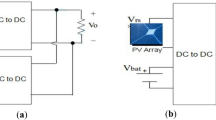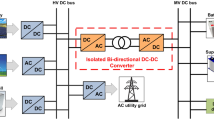Abstract
The classical droop method is widely used in AC microgrid (MG) for sharing load among distributed generations. Apart from interlinking the DC sources, the voltage source inverters control the power flow from renewable energy sources. Thus, they contribute toward the demand side management (DSM) by employing the voltage reduction method (VRM). The VRM is widely utilized in the distribution system of the grid network, its concern is to reduce the voltage in a suitable manner so as to maintain the voltage within the acceptable limits, leading to power savings. However, the application of VRM in the stand-alone MG is very scarce. Thus, this paper attempts to apply VRM so as to achieve not only the benefits pertaining to voltage control but also power savings from DSM. The voltage–current (V–I) droop characteristics are of paramount importance for DSM using VRM to increase the number of consumers during high demand of electrical energy. One of the important contributions is modification of the P–f droop control to maintain the frequency of the MG within the permissible limit while applying VRM. In addition, the behavior of three-phase to ground fault is being investigated and competency of the control algorithm is validated through implementation on 5 bus stand-alone microgrid system and further, it is tested on IEEE 14 bus test system. The efficacy of the proposed approach is established through the comparison of the results with those for classical voltage and frequency-based droop schemes bereft of communication ability. The control mechanism has also been validated in real-time using schematic editor of Typhoon virtual HIL 402.
































Similar content being viewed by others
Abbreviations
- DG:
-
Distributed generation
- MG:
-
Microgrid
- VSI:
-
Voltage source inverter
- CVR:
-
Conservation voltage reduction
- DSM:
-
Demand side management
- VRM:
-
Voltage reduction method
- V–I droop:
-
Voltage–current droop
- VVC:
-
Volt/var control
- PCC:
-
Point of common coupling
- HIL:
-
Hardware in the loop
- \(f_{{{\text{con}}}}\) :
-
Frequency generated by conventional P–f droop
- \(V_{{{\text{con}}}}\) :
-
Voltage generated by conventional QV droop
- \(f_{{{\text{nom}}}}\) :
-
No load frequency
- \(V_{{{\text{nom}}}}\) :
-
Nominal voltage
- \(P_{{{\text{vsi}}}}\) :
-
Active power provided by inverter
- \(Q_{{{\text{vsi}}}}\) :
-
Reactive power provided by inverter
- j :
-
Droop gain of P–f droop
- k :
-
Droop gain of QV droop
- \(f_{{{\text{min}}}}\) :
-
Minimum frequency
- \(V_{{d{\text{-min}}}}\) :
-
Minimum d-axis voltage
- \(P_{{{\text{max}}}}\) :
-
Maximum active power provided by inverter
- \(Q_{{{\text{max}}}}\) :
-
Maximum reactive power provided by inverter
- \(f_{{{\text{op}}}}\) :
-
Operational frequency
- \(V_{{d{\text{-op}}}}\) :
-
Operational d-axis voltage
- \(P_{{{\text{op}}}}\) :
-
Operational active power
- \(Q_{{{\text{op}}}}\) :
-
Operational reactive power
- \(V_{dr}\) :
-
Reference d-axis voltage
- \(V_{qr}\) :
-
Reference q-axis voltage
- \(P_{{{\text{ov}}}}\) :
-
Overloaded active power
- \(Q_{{{\text{ov}}}}\) :
-
Overloaded reactive power
- \(f_{{{\text{ov}}}}\) :
-
Frequency during overloading situation
- \(V_{{d{\text{-ov}}}}\) :
-
Voltage during overloading situation
- \(V_{d}\) :
-
Nominal voltage
- \(I_{{\text{filter,rms}}}\) :
-
Output current provided by the inverter
- \(Z_{L}\) :
-
Droop gain of V–I droop
- \(Z_{1}\) :
-
Network impedance between bus 1 and bus 2
- \(Z_{2}\) :
-
Network impedance between bus 2 and bus 3
- \(Z_{3}\) :
-
Network impedance between bus 3 and bus 4
- \(I_{{\text{R}}}\) :
-
Reduced current corresponding to set voltage of 0.9 p.u.
- \(I_{{\text{d}}}\) :
-
Current demand of the load
References
Kennedy J, Ciufo P, Agalgaonkar A (2016) A review of protection systems for distribution networks embedded with renewable generation. Renew Sustain Energy Rev 58:1308–1317
Arboleya P, Diaz D, Guerrero J, Garcia P, Briz F, Gonzalez-Moran C, Aleixandre JG (2010) An improved control scheme based in droop characteristic for microgrid converters. Electric Power Syst Res 80:1215–1221
Jha SK, Kumar D (2018) Robust decentralized control of parallel type autonomous microgrid structure. In: 2018 International conference on applied electromagnetics, signal processing and communication (AESPC), Bhubaneswar, India, pp 1–6
Jha SK, Ali N, Kumar D (2021) Assessment of V–I droop mechanism to create power reserve for stand-alone microgrid. In: Azar AT, Kamal NA (eds) Advances in nonlinear dynamics and chaos (ANDC), design, analysis, and applications of renewable energy systems. Academic Press, New York, pp 365–392. https://doi.org/10.1016/B978-0-12-824555-2.00029-0
Hatziargyriou N, Asano H, Iravani R, Marnay C (2007) Microgrids. IEEE Power and Energy Mag 5(4):78–94
Jha SK, Kumar D (2019) Demand side management for stand-alone microgrid using coordinated control of battery energy storage system and hybrid renewable energy sources. Electric Power Compon Syst 47(14–15):1261–1273. https://doi.org/10.1080/15325008.2019.1661544
Jha SK, Kumar D (2020) Assessment of battery energy storage system with hybrid renewable energy sources to voltage control of islanded microgrid considering demand-side management capability. Iran J Sci Technol Trans Electr Eng 44:861–877. https://doi.org/10.1007/s40998-019-00273-9
Olivares DE et al (2014) Trends in microgrid control. IEEE Trans Smart Grid 5(4):1905–1919
Pogaku N, Prodanovic M, Green TC (2007) Modeling, analysis and testing of autonomous operation of an inverter-based microgrid. IEEE Trans Power Electron 22(2):613–625
Kahrobaeian A, Mohamed YARI (2014) Analysis and mitigation of low-frequency instabilities in autonomous medium-voltage converterbased microgrids with dynamic loads. IEEE Trans Ind Electron 61(4):1643–1658
Pogaku N, Green T (2006) Harmonic mitigation throughout a distribution system: a distributed-generator-based solution. IEE Proc Gener Transm Distrib 153(3):350–358
Yang S, Wang P, Tang Y, Zhang L (2017) Explicit phase lead filter design in repetitive control for voltage harmonic mitigation of vsi-based islanded microgrids. IEEE Trans Ind Electron 64(1):817–826
Sen PK, Lee KH (2016) Conservation voltage reduction technique: an application guideline for smarter grid. IEEE Trans Ind Appl 52(3):2122–2128
Scalley BR, Kasten DG (1981) The effects of distribution voltage reduction on power and energy consumption. IEEE Trans Educ 24(3):210–216
Gheydi M, Nouri A, Ghadimi N Planning in microgrids with conservation of voltage reduction. IEEE Syst J (in press)
Manbachi M, Nasri M, Shahabi B, Farhangi H, Palizban A, Arzanpour S, Moallem M, Lee DC (2014) Real-time adaptive vvo/cvr topology using multi-agent system and iec 61850-based communication protocol. IEEE Trans Sustain Energy 5(2):587–597
Farrokhabadi M, Canizares CA, Bhattacharya K (2015) Frequency control in isolated/islanded microgrids through voltage regulation. IEEE Trans Smart Grid 99:1–10
Wang Z, Chen B, Wang J, Begovic M (2015) Stochastic dg placement for conservation voltage reduction based on multiple replications procedure. IEEE Trans Power Del 30(3):1039–1047
Wang Z, Wang J (2014) Review on implementation and assessment of conservation voltage reduction. IEEE Trans Power Syst 29(3):1306–1315
Singh R, Tuffner F, Fuller J, Schneider K (2011) Effects of distributed energy resources on conservation voltage reduction (cvr). In: 2011 IEEE power and energysociety general meeting, pp 1–7
Khorsandi A, Ashourloo M, Mokhtari H, Iravani R (2016) Automatic droop control for a low voltage dc microgrid. Gener Transm Distrib IET 10(1):41–47
Moussa H, Shahin A, Martin J, Pierfederici S, Moubayed N (2018) Optimal angle droop for power sharing enhancement with stability improvement in islanded microgrids. IEEE Trans Smart Grid 9(5):5014–5026
Acharya S, Moursi MSE, Al-Hinai A (2018) Coordinated frequency control strategy for an islanded microgrid with demand side management capability. IEEE Trans Energy Convers 33(2):639–651
Jha SK, Kumar D, Lehtonen M (2021) Modified V–I droop based adaptive vector control scheme for demand side management in a stand-alone microgrid. Int J Electr Power Energy Syst 130:106950
Sabzevari K, Karimi S, Khosravi F, Abdi H (2019) Modified droop control for improving adaptive virtual impedance strategy for parallel distributed generation units in islanded microgrids. Int Trans Electr Energy Syst 29:e2689. https://doi.org/10.1002/etep.2689
Barklund E, Pogaku N, Prodanovic M, Hernandez-Aramburo C, Green TC (2008) Energy management in autonomous microgrid using stability-constrained droop control of inverters. IEEE Trans Power Electron 23:2346–2352
Xu Y, Sun H, Gu W, Xu Y, Li Z (2019) Optimal distributed control for secondary frequency and voltage regulation in an islanded microgrid. IEEE Trans Ind Inf 15(1):225–235
Delghavi MB, Yazdani A (2011) An adaptive feedforward compensation for stability enhancement in droop-controlled inverter-based microgrids. IEEE Trans Power Deliv 26:1764–1773
Kim YS, Kim ES, Moon SI (2017) Distributed generation control method for active power sharing and self-frequency recovery in an islanded microgrid. IEEE Trans Power Syst 32(1):544–551
Golsorkhi M, Lu D (2015) A control method for inverter-based islanded microgrids based on V-I droop characteristics. IEEE Trans Power Del 30(3):1196–1204
(2011) IEEE guide for design, operation, and integration of distributed resource island systems with electric power systems. IEEE Std 1547.4–2011, pp 1–54
Mohamed Y-R, El-Saadany E (2008) Adaptive decentralized droop controller to preserve power sharing stability of paralleled inverters in distributed generation microgrids. IEEE Trans Power Electron 23(6):2806–2816
Acknowledgements
This research work is supported under Core Research Grant scheme (Project ID: CRG/2021/007769) of Science and Engineering Research Board (SERB), Department of Science and Technology (DST), Government of India (GoI) to the Department of EEE, BIT—Mesra, Ranchi, India.
Author information
Authors and Affiliations
Corresponding author
Ethics declarations
Conflict of interest
The author confirms that there is no conflict of interest.
Additional information
Publisher's Note
Springer Nature remains neutral with regard to jurisdictional claims in published maps and institutional affiliations.
Appendix
Appendix
The parameters for the cascade control are illustrated as: -
\(K_{ic}\) = 4500; \({\text{Kpc}}\) = 5; \(K_{iv}\) = 300; \(K_{{{\text{pv}}}}\) = 0.085, \(L_{{{\text{filter}}}}\) = 0.1mH, \(C_{{{\text{filter}}}}\) = 3.78 µF,
The parameters for DGs are:
DG_1: 8 kVA, 314 radians/s, \(K_{{{\text{B1}}}}\) = 0.5, H = 0.8, j1 = \(K_{A1}\) = 3e−5 rad/s/W.
DG_2: 12 kVA, 314 radians/s, \(K_{{{\text{B2}}}}\) = 0.5, H = 0.8, j2 = \(K_{A2}\) = 0.7e−5 rad/s/W.
DG_3: 6 kVA, 314 radians/s, \(K_{{{\text{B3}}}}\) = 0.5, H = 0.8, j3 = \(K_{A3}\) = 6e−5 rad/s/W.
The QV droop coefficient is defined as:
k1 = 1e−3 V/Var
k2 = 4e−4 V/Var
k3 = 1.5e−5 V/Var
Rights and permissions
Springer Nature or its licensor holds exclusive rights to this article under a publishing agreement with the author(s) or other rightsholder(s); author self-archiving of the accepted manuscript version of this article is solely governed by the terms of such publishing agreement and applicable law.
About this article
Cite this article
Jha, S.K., Kumar, D. & Mohanta, D.K. Voltage reduction strategy for V–I droop-based stand-alone microgrid considering demand side management capability. Electr Eng 104, 4451–4476 (2022). https://doi.org/10.1007/s00202-022-01632-2
Received:
Accepted:
Published:
Issue Date:
DOI: https://doi.org/10.1007/s00202-022-01632-2




